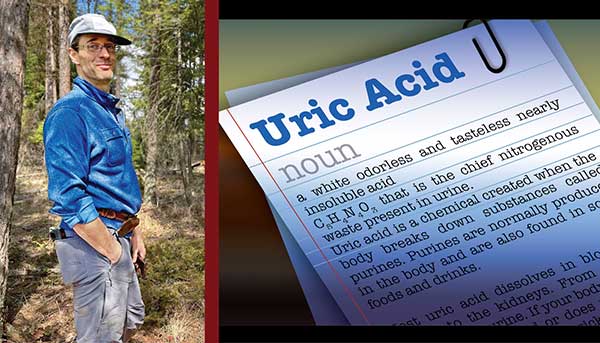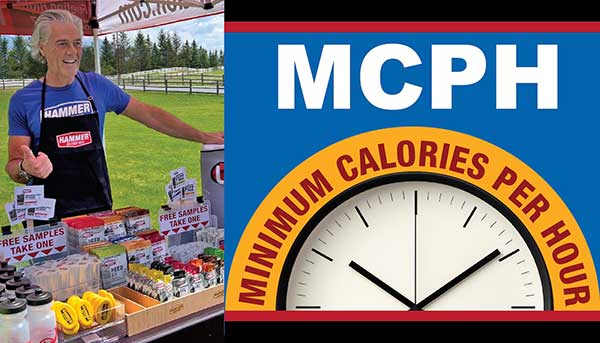
BY DR. BAYNE FRENCH MD DC
*It is worth noting here that I am referring to carbs consumed in your daily diet, not while exercising. That is beyond the scope of this article and will be addressed in subsequent issues of Endurance News. However, I will give you a hint: I use Perpetuem® and Hammer Gel® for my OCR fueling needs!
Now more than ever, sapiens are showing their amazing innate ability to be divisive: good or bad; right or left; true or false; fad diet or wonderful, ancient, panacea for performance-enhancing, adipose-shedding yummy, fatty bits of enlightenment. Like most things diet, there are heaps of misinformation, dogma, and emotion about ketogenic eating. My goal is to help you understand a little more about what’s going on here.
Full disclosure: I have never recommended that patients eat a KD specifically for weight loss. But, if they are interested, I do advise them on how to implement it and its myriad of potential benefits.
Back to Basics
Ketogenic eating is the consumption of a diet that results in the formation of ketones. It is not “you’re in it” or “you’re out of it” (sorry all-or-nothing sapiens); it is a spectrum. More ketones will be produced by any diet lower in carbs than our standard, government-recommended, American-Diabetic-Association-endorsed culinary lunacy. After a 24-hour fast, ketones are commonly 0.5 mmol (millimolar), and many authorities consider this “in ketosis.” A range of one to three mmol is mild-to-moderate ketosis. Fasting is the quickest way to elevate ketones. What we call fasting was starving for the Ancients, our fore-people from the beginning of the Paleolithic era. With both scenarios, ketones are produced. It passes the DIMADS (Does It Make Any Darn Sense) Test that ketones, therefore, do not represent a toxic byproduct; instead, they possess many useful biochemical properties that assisted our transition from the food chains’ midsection to its apex.
The ketogenic and paleo diets are closely related. In fact, being in ketosis was a very natural part of our Paleolithic history. Both diets drastically reduce carbohydrates. Relatively low carb eating is about 130 grams of carb per day or less. Significant ketone generation, however, requires less than 50 grams per day.
Ketone Benefits
- Improved insulin sensitivity
- Muscle sparing (helps prevent the breakdown of our skeletal muscle)
- Effects on gene expression (epigenetics)
- Upregulated internal antioxidant mechanisms, thus improving cellular defense
- Inhibited inflammatory pathways
- Inhibited gluconeogenesis (our bodies’ production of sugar)
- Efficient metabolic fuel
- Increased efficiency and quantity of our mitochondria (our cellular energy factories)
- Reduced appetite
- Weight loss
What’s a ketone anyway?
The metabolism or burning of fats is called beta-oxidation. As a result, acetoacetate and beta-hydroxybutyrate (BHB) are formed. These are our friendly ketones—cute little fellas, much-maligned and misunderstood. (Kinda like me.)
Burgeoning research suggests that ketones, especially BHB, helps to:
- Reduce oxidative stress and inflammation
- Improve the pandemic of insulin resistance
- Epigenetic effects on our gene expression
Our huge brains primarily burn glucose. However, that doesn’t mean we need to eat glucose. We make glucose from other macronutrients in a process called gluconeogenesis. Our jumbo Central Processing Units can also burn ketones. Many patients, once keto-adapted, report to me that their brain fog is gone. Headaches, lack of sleep, mood, and other brain-induced problems also commonly improve.
How to follow the ketogenic diet
Like all matters involving human eating, there is confusion and misinformation about the KD. Most people immediately picture bacon. I don’t blame them; I think about bacon a lot, too. In reality, the KD is not a diet at all but rather a framework based on relative daily caloric percentiles of macronutrients. This means roughly 70% of daily calories should come from fat, 20% from protein, and less than 10% from carbs. You might think, “Ugh, math.” No, it’s simple really. Eat lots of fat from varied sources, and eat some protein. Avoid potato, the Big 4 grains (wheat, corn, rice, and oat), and all forms of sugar. BAM, you’re doing it! Some simplify the carby food to avoid as GPS (grain, potato, and sugar).
People who avoid ALL of the common carb sources listed above are most likely eating less than 50 grams of carb per day. It’s an important place to be if your goal is to produce ketones. Being in this sub-50 club is considered very low carb and may not be sustainable for most endurance athletes. Eating “good carbs” that put you in the low carb range of 50-150 grams per day is a good longterm strategy. Many find this to be the sweet spot for athletic performance, palatability, and sustainability. Ketones will still be made in these carb ranges, especially if you’re supplementing fat and ketones.
Coming soon on the Hammer blog and in the next issue of Endurance News:
- How to Eat Modified Keto while doing 10+ hrs/wk of Endurance Training
- What to Eat When You Want to go Low Carb
The KD, being more of a system than a diet, can be tailored to fit any eating pattern. The popular Mediterranean diet can be a KD. So can a plant-based, vegetarian diet. What about the Standard American Diet (SAD)? Sorry, not that one—no hope for that one!
Why people lose weight on the keto diet
You may be thinking, “But isn’t fat extremely calorically dense? Won’t it go right to my hips?” Actually, weight gain has little to do with calories. Calories from carb spike insulin and calories from fat do not. Eating a low carb, higher fat diet eliminates the postprandial (after eating) blood sugar excursions that drive cravings and hunger. Also, carbs suppress our hunger hormone ghrelin the least. So when carbs are a staple, ghrelin levels quickly spike again after a meal, which drives hunger. Functionally, this mechanism makes sense and has served humans well through history. If we found berries, figs, or a grove of starchy cattail roots, we were hormonally triggered to EAT MORE. (That means we would fight baboons and short-faced bears, search and forage, or open the fridge over and over—whatever it takes to find more.) Over time, with carb restriction and enhanced fat consumption, your total caloric intake is naturally self-restricted, especially if mindfulness with food is practiced. (A future article on that is coming, but it’s more than just what you’re eating; it’s how and when you’re eating.) So even though a ketogenic diet is energetically dense, it’s not at all unusual to consume FEWER overall calories in a day.
If you’re already comfortable with the concepts that fat does not make us fat and fat does not clog our arteries, then congratulations. You are in rarefied air. If you’re struggling with those ideas, then get some crackers and engineered low-fat cheese spread, find a comfortable chair, and read some of my past articles. Basically, any whole fat is good—tallow, lard, marrow, etc. Other excellent minimally processed fat sources include full-fat dairy (not milk) and oils (avocado, coconut, and olive). Find food that is organic, grass-fed, wild-caught, and free-running—insist on eating animals that ate their native food.
Many healthy foods contain carbs, including vegetables, nuts and seeds, fruit, dairy, and even meat. These amounts of carbs are negligible. Fruit intake should be fairly low. Aim for one to two servings per day that are chewed (not blended, mashed, or juiced) and eaten with fat sources. Vegetables vary in how starchy they are (glycemic index). Focus on less starchy ones, but beets, radishes, carrots, and yams CAN be part of a well-constructed KD.
Gradually reduce carbs and increase fat
As mentioned, the fastest way to generate ketones is to simply not eat. If you’re a carb eater, all I can say is good luck. Plummeting insulin levels result in a diuretic effect, so you’ll be going like a racehorse. Also, our meager carb stores in the form of glycogen are linked with considerable water. As we burn up our glycogen (which is important to allow burning and ketone liberation), water is liberated. Oh, and you’ll experience backaches, trouble sleeping, headaches, and just overall want to kill me. Can you imagine our fore-people feeling this way? They would have had to hunt, travel, procreate, build, flee, and fight while feeling like they had been hit by a mastodon. (It passes my DIMADS Test that treating carb as a staple instead of an occasional survival food is an unnatural event.) There is a latency in the transition from sugar burning to fat burning and ketone formation that results in several unpleasant symptoms. Remember, humans are effortless FAT STORERS. This is where the primitive brain wants to be today—silly, old-fashioned brain.
When carb is kept in its rightful place as a garnish, our bodies slowly and reluctantly transition to being FAT BURNERS, which is much healthier. To celebrate my own diet, I wear a tight-fitting half shirt that says, “I burn fat good.” (My 16-year-old hates it, but my 6-year-old wants a matching one.) Anyway, the uncomfortable transition can be ameliorated by a few weeks of gradual carb reduction and fat increase. Adding fat with medium-chain triglycerides (MCT) and using supplemental ketone salts (like KetoCaNa) help reduce symptoms by expediting ketone formation. Another method to expedite the process is the modern equivalent of starving—fasting. Just in the last few years, intermittent fasting (IF) has become mainstream. There is no shortage of podcasts, YouTube posts, and books on the subject, and there are many different methods and protocols. Here’s a little secret, it’s super easy.
The symptoms related to the non-adapted ketotic state has been termed the “Keto Flu.” Again, reducing carbs gradually as fat consumption is ramped up can prevent this. The correct amount of dietary sodium helps, too. Eating a low carb, high-fat diet without many processed foods is a very low sodium diet. For many people, 3-5 grams of sodium per day appears to be a good amount. Research has found that 5g of sodium per day was associated with the lowest risk of death from any cause.5 However, if you eat the SAD or are transitioning from the SAD, you will be REDUCING your sodium intake from the average of 10-15 grams a day.
If you are using a lot of “Keto” branded shakes, bars, and the like, be very mindful of checking for sodium content in these types of products.
It’s okay to be hungry
As part of misguided modern dietary advice, we have been programmed to eat regularly and avoid hunger. Conventional wisdom has told us to limit our portions but to eat regular meals, especially breakfast. I suggest that being hungry is a good thing and a very natural human=animal experience. Our mind and distorted physiology keep us from realizing our full potential as Great Starvers. Oh, and what about eating breakfast every day? It’s not as essential as you’ve been lead to believe. In the morning you’re just starting to burn a little fat, so keep it going! This is the underpinning of fatty coffee. No insulin spike, feel good, fat burning continues. Even beyond skipping breakfast, hunger can be good. Back before more rigorous Institutional Review Boards, Dr. Cahill at Harvard performed human studies involving subjects not eating for 40 days! (I’m told it rained the entire time.) Our modern understanding of hunger and eating patterns don’t align with how our bodies operate and how the Ancients lived.
It takes 2-7 days to generate relatively high amounts of ketones, thus entering “ketosis.” It’s not magic; all people are capable of this as it’s a deeply natural human state. But it does not mean that you are “keto-adapted.” It takes weeks for the multi-organ adaptation in which the body fully learns how to effectively use ketones. It starts quickly, but it takes the body weeks and months to fully adjust. This is not a quick fix—it’s a long-term lifestyle change. One carby meal can rapidly spin the dial back to fat storage.
Summary
Don’t get carried away with the technicalities of the KD or any diet. Any relatively low carb, higher fat way of eating results in lower insulin levels and some ketone generation. But to form higher levels of ketones, your diet choices will need to be more nuanced. I think these higher ketone concentrations do confer health benefits. What isn’t clear to me is the validity of being in ketosis all the time.
It makes sense to me that evolutionarily we normally transitioned to and from higher and lower ketone levels. Herding the now-extinct North American Camel into a pit trap likely resulted in camel meat gorging—no ketones at that feast. A favorable late summery berry forage resulted in high insulin levels and fat formation, which is the antitheses of ketones. The convoluted point I’m making is that intermittently increasing ketone levels is fine.
To help avoid the Keto Flu (and the suggestion to use breath mints by basically everyone you share air with), make sure you drink plenty of water and consume ample salt, vegetables, and fiber.
There is nothing fad about an ancient physiological state. There’s nothing trendy about possessing the cellular machinery to generate an alternative brain fuel, replete with other beneficial metabolic effects. I hope this cleared up any keto-confusion. I need to stop writing now, I haven’t eaten in 5 days and have enough ketones as it is.









14 comments
Thank you for sharing this informative article. It will really help us.
I learned so much from the keto article. Can you tell me how this might affect someone who has high triglycerides?
Thank you,
Teresa
———
Hammer Nutrition replied:
Hello Teresa, Thank you for your comment and question. Triglycerides are definitely associated with dietary sugar consumption. Reducing sugar/sugar like carbs (wheat, potatoes, carrots, etc.) and increasing fat and protein(avocado, raw nuts, olive oil, eggs, meat etc.) intake should have a positive effect on this marker. BDF
Dr. Keto French:
Can you recommend a food list that would provide 70% of calories from healthy fat?
I have some ideas, but would like your expert input
Thanks, Josh
———
Hammer Nutrition replied:
Josh, Staples would include foods that are primarily fat like butter, olive oil, avocado oil, coconut oil, etc. Many excellent fat sources are also good sources of protein like fish, seafood, and grass-fed meat. The downside of these foods, however, is that the protein can reduce ketone formation somewhat. 70% of calories from fat is just a ballpark to efficiently generate ketones, but there are major individual variances in how well we do this. Some can eat less fat and still generate lots of ketones. Other variables include portion sizes and whether intermittent fasting is being employed. A common approach is to eat less pure fat sources but supplement with MCT and ketone salts. It all depends on what your goals are. If goals are to be well into ketosis, then blood or breath ketone monitoring is pretty important, and then make adjustments with protein grams, fat grams, portion sizes, and length of your eating window. I hope that helps.
Sincerely, Bayne
I would love to see a sample eating plan including what you eat before, during, and after training sessions. This article came about 2 weeks after Brian Frank’s article on IF. So, I’m assuming they go hand in hand.
———
Hammer Nutrition replied:
Hello Marcy, Thank you for your comment. All of these articles go together, more or less. Articles such as you suggest are coming – Say tuned!. BDF
I have just had an excellent response to my comment which I have to say now seems foolish and uneducated having received the best scientific information.
If I have offended any reader with my ignorance I apologise. I look forward to reading more articles.Thank you.
———
Hammer Nutrition replied:
Hello Stephen, Oh, I think it is I who should be apologizing – In no way was my reply intended to make you feel or think what you wrote. I greatly appreciate all who take the time to read our articles and comment, positive, negative, or with questions. I love questions! Your questions were valid and prescient – there is a lot of very divergent opinions regarding fueling when it comes to optimal hourly caloric, fluid and electrolyte intake that persists today. (I’ve spent the past 35 years trying to counter these fallacies with logic, science and real world experience, with limited success.) The “replace what you lose” concept of fueling has been and still is what “experts” use to base their high replacement #’s for calories, fluid and electrolytes. On the other end of the spectrum, we pivot from a “less is best” theory where we only want to introduce as much as our body can absorb and utilize in a given period of time. Ironically, the high volume crown tries to discount our message because we sell products? Every reader and athlete has good cause for being confused on this subject. As we continue to talk about diet and health from an entirely non mainstream perspective, I hope you and all readers will feel free to comment, critique and above all, ask more questions. The ones received on this article and several previous have already spawned a half dozen future articles that Steve, Bayne and I will be addressing in the coming weeks and months. We are basically guided by the feedback and questions we receive because no one knows better what they do and don’t know/understand than you. Thank you again for all of your comments. BDF